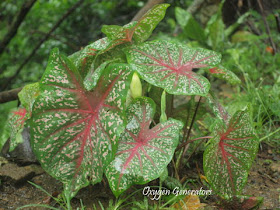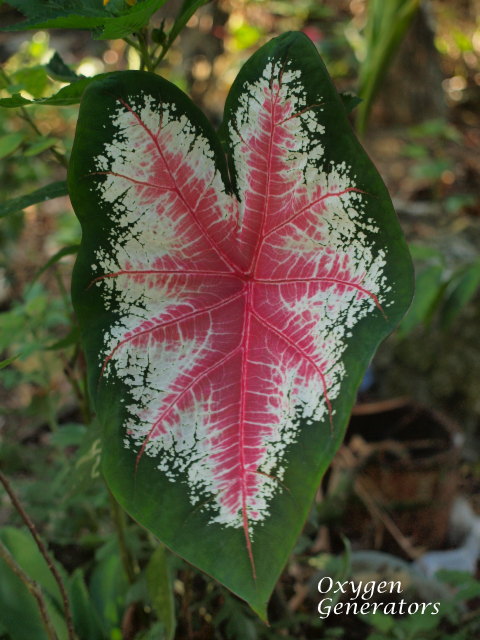This is only planted here from cuttings for about two years now. We all love the pattern of its venation, with deep yellow veins on dark green background. It surely is a lovely plant in any area even with just the foliage. It also grows well despite drought and without any supplemental water during the dry season. Leaves just wilt at mid-day which eventually becomes turgid again in the evening. Every apical portion produced some tubular small flowers at the height of the dry season but is not really pretty. We tried to cut these flowering spikes to give way for the leaves.
After the first heavy rains, i cut all the lower branches to expose the Song of India (Dracaena reflexa) and Ixora coccinea, which now has totally lost blooms and some leaves. The latter already suffered severely with only younger leaves showing health. I hope it will now recover.
The above is the Ixora when it is not yet covered by the Sanchezia.
These are the pruned branches. They will just go to waste for food of the earthworms, fungus and bacteria. And you know what! My sister further fully cut all the top stems of the Sanchezia, to give way to better growths. Unfortunately, i forgot to take the photo of the bald plant, but it really looks pathetic at the moment.
Fate of the caladiums, (Caladium bicolor)
Caladiums favorably grow in our climate. They just become dormant underground during the dry season and produce leaves again when the rains come. We have them for many years now and some corms might have been carried by floods or chicken, as they can be seen around the property already. Sometimes, i am thinking that winter is even an advantage to temperate gardeners. Their corms and bulbs will not persist outdoors during their winter season. If the gardener wants to preserve the plant, they have to keep it inside for protection. In our case in the tropics, they will just show up repeatedly through time, multiply itself anywhere, until people will not be enamored with them at all.
One plant produced a healthy flower. However, this plant is very near the pathway and should be removed.
I also love this green and white variant. In fertile soils it produces big leaves and slender long petioles. I purposely planted it in an area with shallow top soil, so the petioles will be shorter. I am glad about the result as in above.
The variants above and below have single leaf each. It takes a while before the next leaves grow because this is in a shaded area.
Another variant, whose petioles are shorter than the above colors. However, i only have one plant of this variant. I am still on the look-out for varieties available here. I am always envious of those i see in Meems garden at Hoe and Shovel in Florida.


.jpg)










I love Caldiums. Such beautiful plants to have in the garden. I have them growing in pots but they require lots of water! But they do look good when they are full. I always hate pruning plants back but I know it's one of importance:) It all comes back fuller and healthier than before....that's is....if we've pruned properly:)
ReplyDeleteBeautiful Caladiums, what a feast for the eye with their special colors and textures, thank you for featuring them
ReplyDeleteHi Klara, i was able to open your wonderful cymbidium, super fabulous indeed, but the security captsa doesn't open well so i can't put my reply there. I tried many times but to no avail.
DeleteI love the colourings in the caladiums. Once I bought one and then it started dyeing off and I ditched it! Hadn't realized it was a bulb-based plant and that it would regenerate after the colder months. So beautiful they are....
ReplyDeleteHahaha Carole, that experience i am sure you will never ever forget!
DeleteI love caladiums and I miss those that sprout like a wildflower on the ground everywhere. Now, I wish some will just appear right on my garden.
ReplyDeleteI don't think you will get volunteers if you just have a garden. Volunteers happen if you have a property more than a garden, left on its own to the elements. We just have a small area near the house as garden although not well kept too! So the adjacent area around the house is a potential area for volunteers, even avocados, haha!
DeleteI love your caladiums...so many varieties. I cannot really grow them here except as an annual...just beautiful
ReplyDeleteAndrea,
ReplyDeleteLoved the Caladiums you have in your garden. The one with the dark pink center and whitish edging is stunning. Yes our bees are Apis mellifera, they produce more honey than your Apis cerana yet are much more prone to varroa mites. Some in the US have A. cerana but I have never met anyone that has them.
great collection of caladiums, such beautiful combination of colours. I love them too but mine are still sleeping. I hope they will prosper well in my garden.
ReplyDeleteWe can only have them as houseplants here Andrea though so easily killed if they get watered too much. I always admire the beautiful markings on their leaves. I really hope that those terrible rains cease soon - I head about them on our news today.
ReplyDeleteStay safe Andrea
Rosie x
I really enjoy looking at your collection of Caladiums.
ReplyDeleteI have 2 varieties in my garden. (one had disappeared)
I guess they do go dormant time to time.
Caladiums really give a lot of colour to the garden.